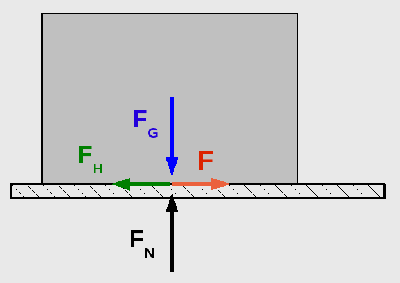|
|
|
|
News The Project Technology RoboSpatium Contribute Subject index Download Responses Games Gadgets Contact <<< Rolling friction Java-Applet drag race >>> Static and kinetic frictionTerminologyFriction is the inhibition of movement. At the previous chapter we examined the internal friction, occurring while objects are deformed. Theme of this chapter is the external friction, occurring at the contact area of two touching objects. We have to differentiate between static friction, where at no movement between the objects takes place and kinetic friction where at the surfaces of the two objects move against each other. The reasons of the occurrence force are the molecular or ionic attraction and the roughness, leading to a toothing of the surfaces.Static friction occurs between non-moving solid surfaces in contact. If the attracting force becomes larger than the maximum static friction, the objects start moving relative to each other and kinetic friction is the result. The maximum amount of static friction is higher than the force caused by kinetic friction. In practiceAt the previous chapter we examined friction as unwanted effect when objects roll on surfaces. Who ever tried to walk on a frozen surface, wearing normal shoes will have realized that friction can be very helpful, too. A similar experience is a full brake application at frozen streets. The dramatic decrease of friction force between tire respectively sole of the shoe and the earth's surface causes a decrease of the accelerating forces, too. To accelerate objects (even breaking means accelerating against the direction of movement), forces have to act. The accelerating force is transmitted by the contact area of object and earth's surface. We permanently push ourself away from the planet to move forward at the surface. To avoid slipping (sliding), the accelerating force must always be lower than the maximum of the static friction. The grip of the surfaces related to each other is described by the coefficient of friction.Balance of forces
An object resting on a horizontal surface is attracted downwards by the force caused by gravity (FG). The counterpart of the gravitational force is the normal force (FN) pointing to the opposite direction with exactly the same scalar absolute value. As a result there is no movement of the object. If an additional force (F) acts in parallel to the contact area, the static friction (FF) inhibits the movement by pointing into the opposite direction with the same magnitude. Since the magnitude of the applied force (F) becomes lager than the maximum of the static friction (FF), the object starts moving into the direction of the applied force. If an object is moving with constant speed along the contact area, the counterforce is caused by kinetic friction. The forces caused by static or kinetic friction depend on the properties of the contacting surfaces, the roughness (toothing) and the force pointing perpendicular to the contact area (normal force). The ratio of the force of friction between two bodies and the force pressing them together, is described by the coefficient of friction. This dimensionless scalar value is symbolized by the Greek letter μ. Static and kinetic friction are governed by the following equations:
Static friction: FF,S - Static friction, FN - normal force, μS - coefficient of static friction FF,Smax - maximum of static friction FF,K - kinetic friction, μK - coefficient of kinetic friction ApplicationsCar tires have to be designed for contradicting properties. At the chapter belonging rolling friction, we examined that they should be hard to minimize this kind of friction. In contrast the desired static friction requires soft tires. The higher the static friction, the shorter the stopping distance and while speeding up you also need a maximum of grip.Looking at the formulas above, you can see that static and kinetic friction are independent from the contact area. But why do racing cars have wide-based-tires? Because those wide-based-tires consist of soft rubber materials. If they would use narrow, soft tires, they would be kneaded much more because of the car weight. So those tires would heat up too much and blow up! When doing a full brake application with locked tires or during a burnout, kinetic friction operates. As beloning to the formulas above, this kind of force is independent from the speed of the car. The static coefficient of friction varies with the properties of the surfaces. It is 0.65 between a car tire and dry concrete, 0.40 between tire and wet asphalt and less than 0.2 between tire and ice! Drag raceUntouched by the discussions belonging energy saving, the Java-application at the next page is addicted to drag racing. You have to cross the distance of 1/4 mile as fast as possible. With the help of the throttle pedal (throttle-mouse) you should release as much power as possible, but without spinning wheels. Spinning wheels means accelerating with the lower kinetic friction than with higher static friction. You have to reduce throttle until the tires stop spinning and push the throttle again to accelerate as fast as possible.The more slippery the racing track becomes, the less power you should release. You will see that you win or lose the race within the first meters. The reason for this will be examined at the chapter concerning energy and power. <<< Rolling friction Java-Applet drag race >>> News The Project Technology RoboSpatium Contribute Subject index Archives Download Responses Games Links Gadgets Contact Imprint |
|
|